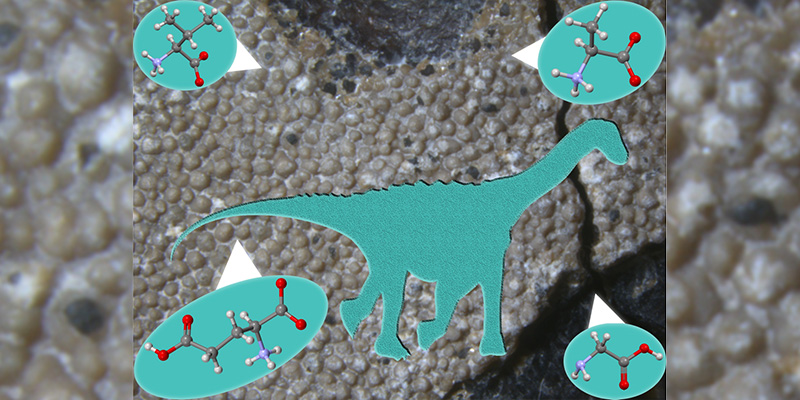Ancient amino acids found in dinosaur eggshell
An international team of researchers from the University of York, USA, Spain, Argentina, China, Denmark and Italy have successfully analysed dinosaur eggshell fragments to find ancient amino acids, the building blocks of proteins.

The research suggests that these fossil biomolecules are possibly the best-supported protein-related material from a dinosaur yet described.
Although the sequence of amino acids in the original proteins are lost, the researchers hope that the free amino acids can improve future studies of prehistoric materials by focusing chemical analyses only on molecules coming from the organisms themselves, rather than environmental contamination.
Evan Saitta, a postdoctoral researcher at the University of Chicago and lead author of the study, had been searching for ancient amino acids in dinosaur bones with Kirsty Penkman’s University of York lab during his doctoral work under Jakob Vinther at the University of Bristol. There was no success using dinosaur bones: there were no signs of original proteins, and the bones in fact provided a habitat for a community of modern microbes.
However, Saitta had also brought with him a small fragment of eggshell from a titanosaur, the group of Late Cretaceous herbivorous sauropod dinosaurs that included the largest ever to live. He had been gifted this eggshell as a boy, but the success of previous work on bird eggshell by the York team meant that this provided an opportunity to test the approach on material that was more amenable to destructive analysis. The researchers analysed the eggshell with various chemical techniques, including high-performance liquid chromatography.
Kirsty Penkman said, “when the results began to print off the machines at York, I was hopping around the lab cheering - it was so clear from the pattern that these were original Cretaceous amino acids.”
In life, these asymmetrically structured amino acids all exist in the same one form of their two possible mirror-image states and are linked together into proteins through peptide bonds. After death, as proteins fragment through the insertion of water molecules at these bonds, free amino acids are released. These free amino acids equilibrate over time into 50-50 mixtures of the two mirror-image forms. The amino acids in the dinosaur eggshell showed this 50-50 mixture, indicating that they were very ancient. The eggshell also appeared to contain only four of the most thermally stable amino acids – glutamic acid, glycine, alanine and possibly valine – in ratios consistent with predictions of degradation from younger fossil bird eggshells and heating experiments, as well as other ancient fossils.
The researchers’ results were further supported by signatures consistent with ancient organic material and amino acids from other chemical analyses, including mass spectrometry and spectroscopy. The success of these first analyses led them to obtain material from curated dinosaur eggshell, and the characteristic signatures were also observed in other titanosaur eggshells from Argentina and Spain, as well as ‘duck-billed’ hadrosaur dinosaur eggshells from China. Eggshell is made of biologically produced calcite – a mineral that can trap proteins involved in calcification within a ‘closed system’ that retains their breakdown products while excluding outside contamination.
The ~86-66-million-year-old amino acids trapped in this calcite “time capsule” show all the tell-tale signs of extreme degradation: separating from their protein chain as free molecules, equilibrating from their original structural conformation, and completely degrading the less thermally stable amino acid types. Sadly, unlike recent studies of much younger ~6.5-million-year-old fossil bird eggshell performed by co-author Beatrice Demarchi’s team, the dinosaur eggshell lacked any identifiable protein sequences when examined with mass spectrometry at the University of Turin and the University of Copenhagen.
Although attempting to predict the sequences of their precursor proteins using this limited set of amino acids would be the equivalent of taking a novel and selectively removing all but five letters, identifying original biomolecules from the dinosaurs may still yield fruitful insights into these prehistoric creatures and their environment.
Evan Saitta said, “We are excited about the potential of very ancient amino acids in calcite, and we hope to push the envelope even further back in time in future studies”.
The study, “Non-Avian Dinosaur Eggshell Calcite Can Contain Ancient, Endogenous Amino Acids,” was published in Geochimica et Cosmochimica Acta in January 2024, and a Conversation article covering the work was published this week. The York team included Dr Molly Crisp, Dr Lucy Wheeler, Dr Sam Presslee, Dr Marc Dickinson and Professor. Kirsty Penkman.